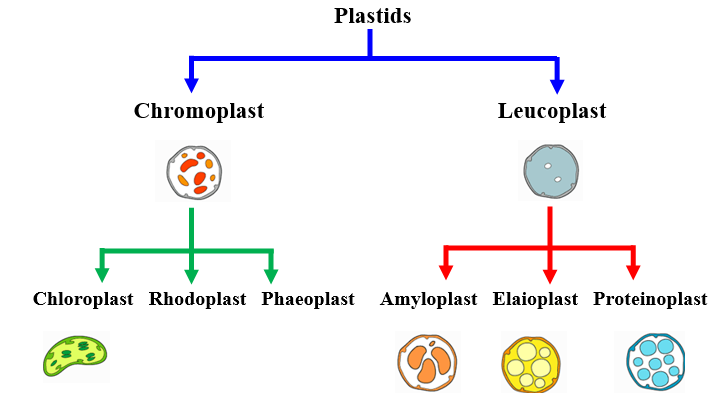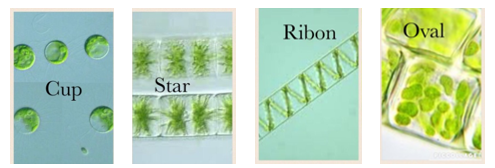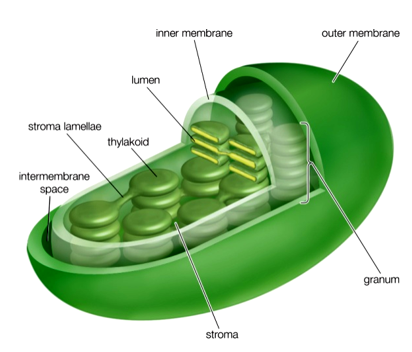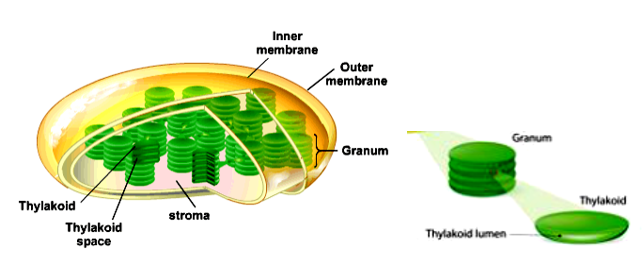These are present only in plant cells. They synthesize and store carbohydrates. The term plastid (Plastikas -formed) was proposed by Schimper in 1885.
The plastids are broadly classified into two main types – Chromoplasts and Leucoplasts.

Chromoplasts
These are coloured plastids, which contain various pigments. Based on their colour, chromoplasts are further subdivided into Chloroplast, Phaeoplast and Rhodoplast.
Chloroplast
This plastid is green in colour (chlor-green; plast-living). It contains a green pigment called chlorophyll. They are the sites of photosynthesis.
- The size of chloroplasts varies from species to species. Generally the chloroplast of plants growing in shades is larger in size.
- The number of chloroplast also varies from plant to plant, but it remains constant in all cells of a plant.
- The shape also varies. In green algae chloroplasts have various shapes. For e.g.,
-
- Cup shaped in Chlamydomonas,
- Spirally coiled in Spirogyra,
- Girdle shaped in Ulothrix,
- Star shaped in gnema,
- Disc shaped in Caulerpa,
- Reticulate in Oedogonium etc.
-

Structure
- The chloroplast is bounded by two unit membranes, namely an outer and inner membrane.
- The two membranes are separated by a space called peri-plastidial space.
- Both the membranes are proteinaceous in nature.
- The outer membrane is freely permeable and the inner membrane is semi permeable.

- The interior of chloroplast is filled with a colloidal substance called stroma.
- It is transparent and proteinaccous in nature.
- It contains double stranded DNAs, 70S ribosomes, many enzymes and starch grains.
- In the stroma there are many closed flattened sacs called thylakoids (sac like).
- Each thylakoid is bounded by a single unit membrane and it encloses a cavity called loculus.
- They are arranged one above the other in the form of a stack of discs like the piles of coins.
- This structure is called granum (grana- plural).
- The thylakoids of adjacent grana are interconnected by numerous tubules called frets or stromal lamellae or stroma thylakoids.
- The granum is the site of light reaction and stroma is the site of dark reaction in photosynthesis.

- The DNA of chloroplastis circular in shape and double stranded.
- It is concerned with cytoplasmic inheritance, protein synthesis and self duplication.
- The chloroplasts are semi autonomous organelles like mitochondria.
- The ribosomes of the chloroplasts are smaller (70S) than the cytoplasmic ribosomes (80S).
Functions
- Photosynthesis.
- Protein synthesis due to the presence of DNA and ribosomes.
- Starch storage.
- Cytoplasmic inheritance (due to the presence of DNA).
Phaeoplast
This is dark or brown in colour, which contains a pigment called fucoxanthin. Its main function is to absorb light and transfer energy to algae, diatoms etc.
Rhodoplast
This is red in colour due to the presence of a red pigment called phycoerythrin. Its main function is to absorb light. It is found in red algae
Leucoplasts
These are colourless plastids (Leuco-white, plast-living). They are not involved in synthetic activities and are concerned with the storage of food materials.
The Leucoplasts are subdivided into
- Amyloplast: It is found in tubers, cotyledons and endosperm. It stores starch.
- Elaioplast: It is found in epidermal cells of Orchidaceae and Liliaceae. It stores oils
- Proteinoplast / Aleuroplasts: It is found in seeds and nuts. It stores protein.